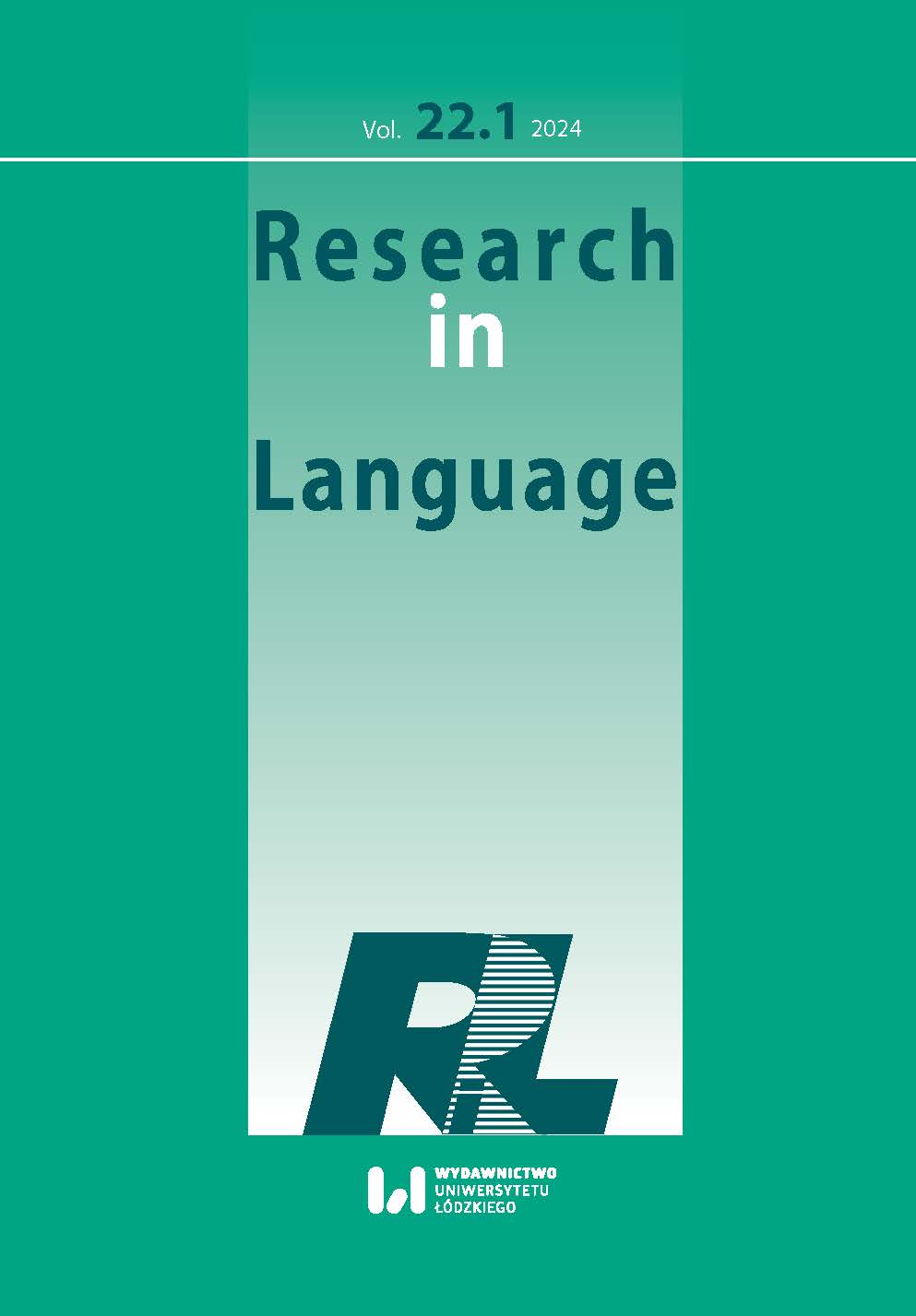Selected Acoustic Features of the Welsh Lateral Fricative /ɫ/
DOI:
https://doi.org/10.18778/1731-7533.22.1.03Keywords:
laryngeal fricative, aspiration, spectral moments, fricatives, Welsh consonantsAbstract
The Welsh language exhibits a number of features uncommon from a cross-linguistic point of view, one of which is a relatively large number of fricative phonemes. This paper analyses selected acoustic features of the Welsh lateral fricative /ɬ/ in order to contribute to the debate on the laryngeal system in Welsh and the classification of /ɬ/ within that system. Total articulation length, voicing length and SMA parameters of the friction period are measured and analysed on the basis of recordings of 6 native speakers of Welsh. The results confirm the classification of /ɬ/ as a fortis sound proposed in earlier studies (Asmus and Grawunder 2017, Baran forthcoming) and suggest that the Welsh /ɬ/ may exhibit aspiration.
References
Asmus, Sabine and Sven Grawunder, 2017. Vowel length in Welsh monosyllables, its interrelation with Irish and related problems. Lewiston: Edwin Mellen Press.
Google Scholar
Asmus, Sabine, Sylwester, Jaworski and Michał Baran, 2019. Fortis-Lenis or Voiced-Voiceless – Features of Welsh Consonants. Proceedings of the International Conference of the Phonetic Sciences XIX, pp. 3773-3776.
Google Scholar
Asu, Lina E., Nolan, Francis and Susanne Schötz, 2015. Comparative Study of Estonian Swedish Voiceless Laterals: Are Voiceless Approximants Fricatives? Proceedings of the International Conference of the Phonetic Sciences XVIII.
Google Scholar
Awbery, Gwenllian M., 1984. Phonotactic Constraints in Welsh. In: Ball, M.J. and G.E. Jones, eds. Welsh Phonology: Selected Readings. Cardiff: University of Wales Press.
Google Scholar
Ball, Martin J. and Nicole Müller, 1992. Mutation in Welsh. London and New York: Routledge.
Google Scholar
Baran, Michał, Defining the fortis/lenis and voiceless/voiced distinction of consonants in Welsh and English. Forthcoming
Google Scholar
Baran, Michał, 2020. Fortis-Lenis Distinction of Fricatives and Plosives in Welsh – Phonetically Distinctive Factors. Linguistics Beyond and Within, vol. 6, pp. 47-59. https://doi.org/10.31743/lingbaw.11830
Google Scholar
DOI: https://doi.org/10.31743/lingbaw.11830
Boersma, Paul, and David Weenink, 2019. “Praat: Doing Phonetics by Computer” (version 5.3.43) (DOA December 18, 2022).
Google Scholar
Filppula, Markku, Klemola Juhani and Heli Paulasto, 2008. English and Celtic in Contact. London and New York: Routledge. https://doi.org/10.4324/9780203895009
Google Scholar
DOI: https://doi.org/10.4324/9780203895009
Hannahs, S.J., 2013. The Phonology of Welsh. Oxford: Oxford University Press. https://doi.org/10.1093/acprof:oso/9780199601233.001.0001
Google Scholar
DOI: https://doi.org/10.1093/acprof:oso/9780199601233.001.0001
Jaworski, Sylwester and Michał Baran, 2021. Acoustic features of burst release: a study of Welsh plosives. Roczniki Humanistyczne, vol. 69, no. 11, pp. 89-105. https://doi.org/10.18290/rh216911-5s
Google Scholar
DOI: https://doi.org/10.18290/rh216911-5s
Jones, Glyn E., 1984. The Distinctive Vowels and Consonants of Welsh. In: Ball, Martin J. and Glyn E. Jones, eds. Welsh Phonology: Selected Readings. Cardiff: University of Wales Press.
Google Scholar
Jones, Glyn E. and Francis Nolan, 2007. An Acoustic Study of North Welsh Voiceless Fricatives. Proceedings of the International Conference of the Phonetic Sciences XVI, pp. 873-876.
Google Scholar
Ladefoged, Peter and Ian Maddieson, 1996. The Sounds of the World’s Languages. Cambridge: Blackwell Publishers.
Google Scholar
Lee, Sungmin, 2020. Spectral analysis of english fricatives /s/ and /ʃ/ produced by people with profound hearing loss. Clinical Archives of Communication Disorders, vol. 5, no. 3, pp. 147-153. https://doi.org/10.21849/cacd.2020.00269
Google Scholar
DOI: https://doi.org/10.21849/cacd.2020.00269
Maddieson, Ian and Karen Emmorey, 1984. Is There a Valid Distinction between Voiceless Lateral Approximants and Fricatives? Phonetica, vol. 41, pp. 181-190. https://doi.org/10.1159/000261725
Google Scholar
DOI: https://doi.org/10.1159/000261725
Roach, Peter, 2012. English Phonetics and Phonology. Cambridge: Cambridge University Press.
Google Scholar
Schrijver, Peter, 1995. Studies in British Celtic Historical Phonology. Amsterdam: Rodopi. https://doi.org/10.1163/9789004653733
Google Scholar
DOI: https://doi.org/10.1163/9789004653733
Steed, William and Peter Hardie, 2004. Acoustic Properties of the Kuman Voiceless Velar Lateral Fricative. Proceedings of the 10th Australian International Conference on Speech Science & Technology, pp. 346-351.
Google Scholar
Watkins, T. Arwyn, 2002. Welsh. In: M.J. Ball and J. Fife, eds. The Celtic Languages. London and New York: Routledge, pp. 289-348.
Google Scholar
Downloads
Published
How to Cite
Issue
Section
License

This work is licensed under a Creative Commons Attribution-NonCommercial-NoDerivatives 4.0 International License.










